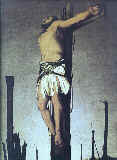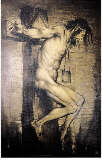 Once you come down from Donizetti’s studio in Cittą Alta, to the Arsmedia
Gallery lying in the artistic heart of Bergamo between the Carrara and Modern Art
Galleries, these drawings express the fascination of secret papers - hundreds of sheets
kept by the painter with incomparable care, perhaps because of the innate fragility of
pencil and paper, although this is only an apparent fragility, in fact able to resist the
passing of centuries.
Once you come down from Donizetti’s studio in Cittą Alta, to the Arsmedia
Gallery lying in the artistic heart of Bergamo between the Carrara and Modern Art
Galleries, these drawings express the fascination of secret papers - hundreds of sheets
kept by the painter with incomparable care, perhaps because of the innate fragility of
pencil and paper, although this is only an apparent fragility, in fact able to resist the
passing of centuries.
Just a glance at these drawings and the art and philosophy of Donizetti is immediately revealed. "They express the Being, the Spirit, they express Life – wrote Jean-Louis Ferrier – There is a ‘design’ within the drawing…". An intention, an aim, an end. And the end is also sometimes the painting of which they are repeated studies, a trace of an evolving idea.
 But to remain within the sphere of the exhibition, look, for
example, at an initial drawing (1950) of the highly dramatic Crucifixion (1951) on the
cover of the catalogue. The body of Christ is depicted almost horizontally, as if only
laid on the cross. The soldiers have not yet crucified him with the nails and have not
even bound him as in the finished picture. The right leg is bent at a greater angle, the
cross is still not raised in all the bold and unusual prospective of the painting, in all
its extremely human drama. Christ’s eyes still watch us. In the painting, on the
other hand, they are closed in the darkness of death, or rather in the anguishing gloom of
the descent to the Underworld, which the foreshortened view on a dark blue background
accentuates. That Christ is humanity itself suffering, it is man nailed and bound to the
cross of injustice and of extreme poverty, it is man alone without even the compassion of
a mother, brother or a ‘devout woman’. It would appear to be a Christ to whom
Resurrection is denied. But on "the third day…".
But to remain within the sphere of the exhibition, look, for
example, at an initial drawing (1950) of the highly dramatic Crucifixion (1951) on the
cover of the catalogue. The body of Christ is depicted almost horizontally, as if only
laid on the cross. The soldiers have not yet crucified him with the nails and have not
even bound him as in the finished picture. The right leg is bent at a greater angle, the
cross is still not raised in all the bold and unusual prospective of the painting, in all
its extremely human drama. Christ’s eyes still watch us. In the painting, on the
other hand, they are closed in the darkness of death, or rather in the anguishing gloom of
the descent to the Underworld, which the foreshortened view on a dark blue background
accentuates. That Christ is humanity itself suffering, it is man nailed and bound to the
cross of injustice and of extreme poverty, it is man alone without even the compassion of
a mother, brother or a ‘devout woman’. It would appear to be a Christ to whom
Resurrection is denied. But on "the third day…".
 "The third day" will come for the crucified man as well.
In the end, this is the great promise of the Beatitudes.
"The third day" will come for the crucified man as well.
In the end, this is the great promise of the Beatitudes.
The solitude is terrible and desolate in the other Crucifixion
exhibited, too, which was painted in 1959. The palette has lightened and the background
with it.
But in the clear and leaden light, the trees are nothing but sterile black poles,
scaffolds for further crucifixions.
 Along with these two painted Crucifixions, there is also the cartoon
for the Crucifixion (1969) on exhibition in the Museum of the Treasury in the Vatican.
Never has a crucified person been more dramatic, never so humiliated, never so nude, never
so defenceless but, at the same time, great and epic. Colours of darkness, slate grey and
misty, are in agony with the Christ. The reason for the judgement is not written a the top
of the cross, but shamefully hung round the neck of Jesus. His body, with the legs bent at
sharp angles, is sitting on a board which extends out from the cross itself, obscure and
huge. The last glance of his dying agony is for the blind cruelty of man as a crowd, of
man as an individual, of man as power. "Father, forgive them for they know not what
they do". We take part in something dreadful and majestic which implicates us and
makes us suffer.
Along with these two painted Crucifixions, there is also the cartoon
for the Crucifixion (1969) on exhibition in the Museum of the Treasury in the Vatican.
Never has a crucified person been more dramatic, never so humiliated, never so nude, never
so defenceless but, at the same time, great and epic. Colours of darkness, slate grey and
misty, are in agony with the Christ. The reason for the judgement is not written a the top
of the cross, but shamefully hung round the neck of Jesus. His body, with the legs bent at
sharp angles, is sitting on a board which extends out from the cross itself, obscure and
huge. The last glance of his dying agony is for the blind cruelty of man as a crowd, of
man as an individual, of man as power. "Father, forgive them for they know not what
they do". We take part in something dreadful and majestic which implicates us and
makes us suffer.
Silvana Milesi